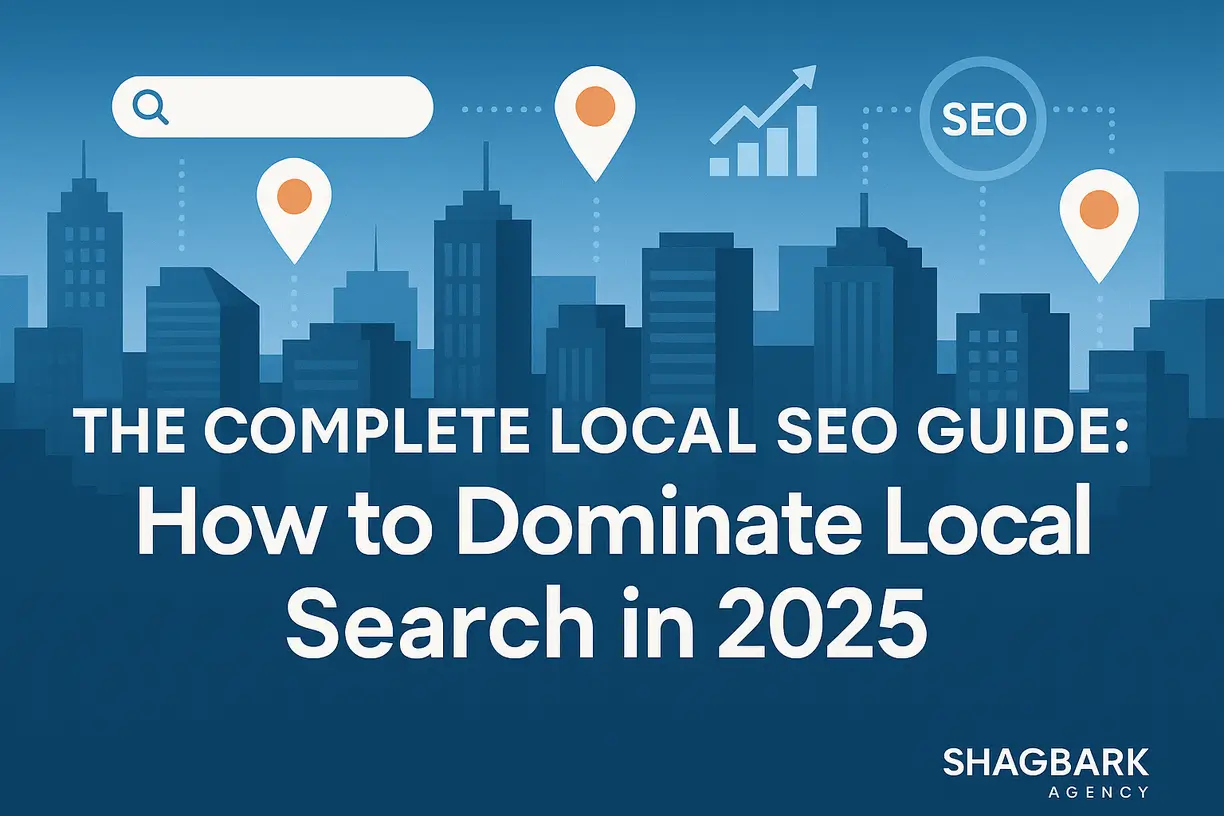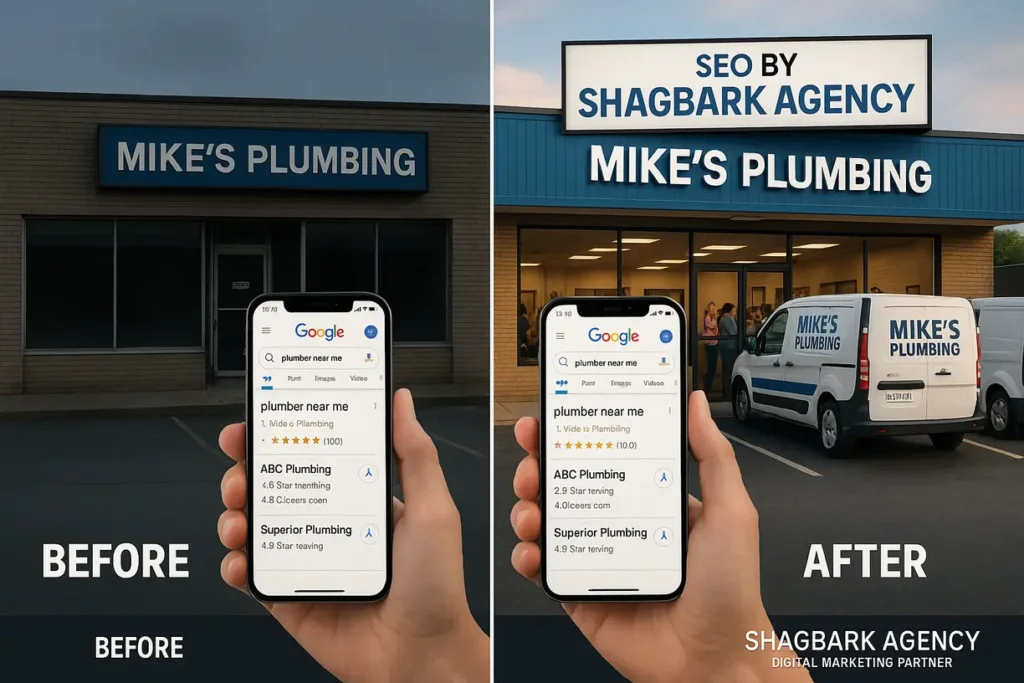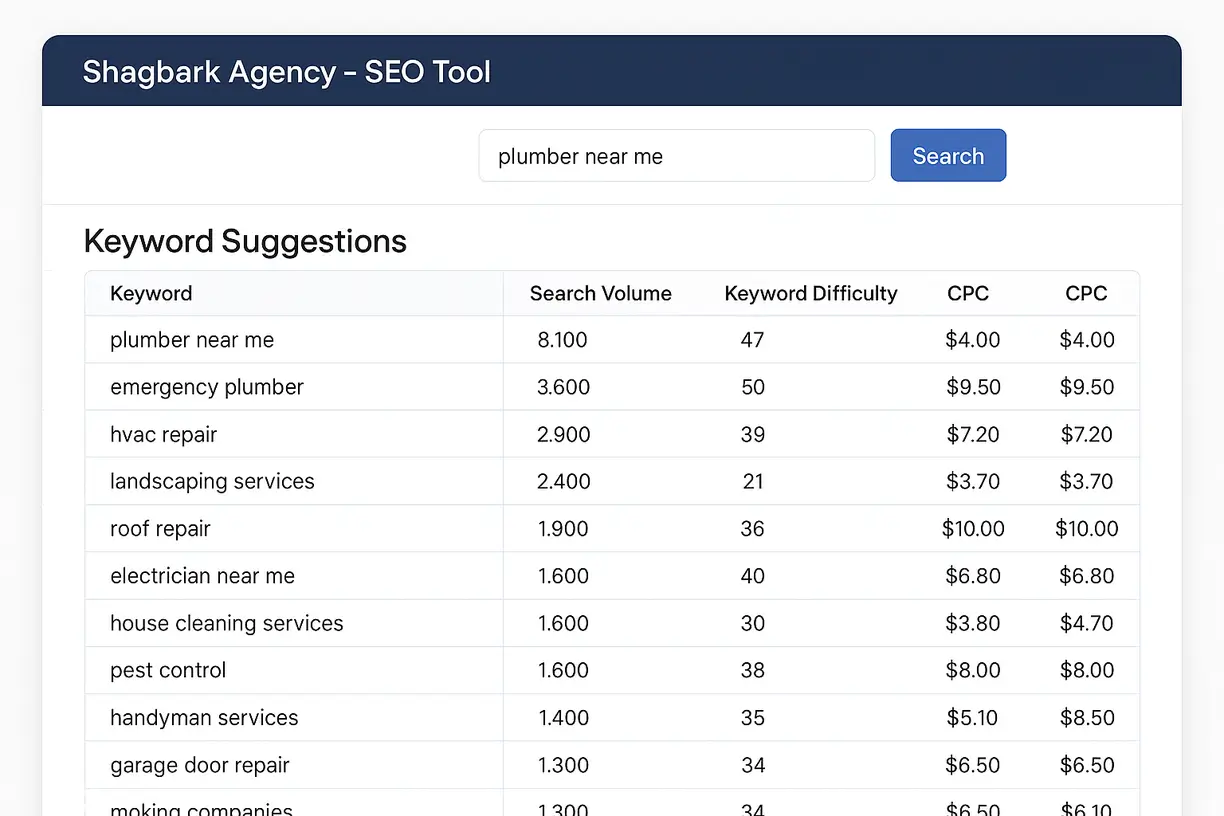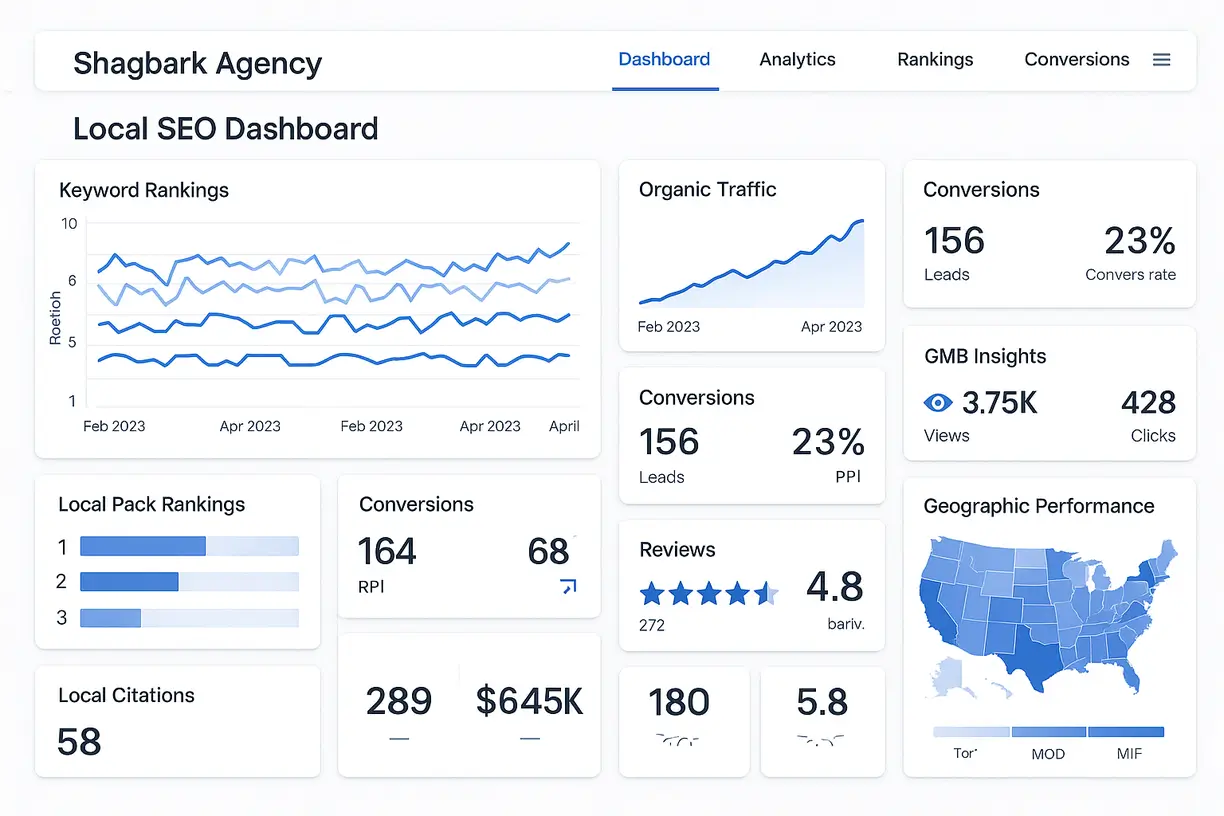
Local businesses today face unprecedented competition in the digital marketplace. With 97% of consumers searching online for local businesses, mastering this comprehensive local seo guide isn’t just an advantage—it’s essential for survival. Whether you’re a restaurant owner, dentist, or service provider, local search engine optimization determines whether potential customers find your business or your competitors’.
This definitive guide to local seo will transform how you approach local search marketing. You’ll discover proven strategies that drive real results, practical frameworks that save time, and actionable tactics that increase your visibility where it matters most.

Key Takeaways
- Foundation First: Optimize Google Business Profile completely before advancing to complex strategies—it directly impacts all local ranking factors
- Consistency Counts: Maintain identical NAP (Name, Address, Phone) information across all online platforms to strengthen local authority
- Content Connects: Create location-specific, valuable content that addresses local customer needs and incorporates geographic keywords naturally
- Reviews Rule: Actively manage online reviews by encouraging positive feedback and responding professionally to all customer comments
- Measure Progress: Track local-specific metrics including Google Business Profile insights, local keyword rankings, and conversion data to demonstrate ROI
- Competition Analysis: Regularly analyze local competitors’ strategies to identify gaps and opportunities in your market
- Mobile Matters: Prioritize mobile optimization since most local searches occur on mobile devices with immediate purchase intent
- Authority Building: Develop local citations and backlinks from relevant area businesses, directories, and organizations to establish market credibility
What is Local SEO and Why It Matters
Local SEO is the strategic process of optimizing your online presence to attract customers from location-specific searches. When someone searches “best pizza near me” or “dentist in Chicago,” local SEO determines which businesses appear in those critical top positions.
Unlike traditional SEO that targets broad, national audiences, local SEO focuses on capturing customers in your immediate geographic area. This targeted approach typically generates higher conversion rates because local searchers often have immediate purchase intent.
The business impact is substantial. Local searches drive 28% of all searches and result in purchases 18% of the time. More importantly, 88% of consumers who perform a local search visit or contact a business within 24 hours.
For business owners, this represents a massive opportunity. Local SEO levels the playing field, allowing small businesses to compete effectively against larger chains by dominating their local market share.
Pro Tip: Start tracking your current local search visibility using Google Search Console’s Performance report filtered by location. This baseline will help you measure improvement as you implement these strategies.
Understanding Local Search Fundamentals
Google evaluates local businesses using three primary ranking factors: relevance, distance, and prominence. Understanding these factors is crucial for any beginners guide to local seo strategy.
Relevance measures how well your business matches what the searcher wants. If someone searches for “emergency plumber,” Google analyzes your business category, services, and content to determine relevance.
Distance considers the proximity between the searcher’s location and your business. While you can’t change your physical location, you can optimize for multiple service areas through strategic content creation.
Prominence evaluates your business’s overall authority and reputation. Google considers factors like review quantity and quality, local citations, and how well-known your business is both online and offline.
The local search landscape includes several result types. The Local Pack (map with three business listings) typically appears at the top, followed by organic local results. Knowledge panels for specific businesses may also appear, providing detailed information directly in search results.
Understanding user search behavior helps optimize your approach. Mobile searches dominate local queries, with users often searching while actively traveling to make purchases. This creates urgency that smart businesses can capitalize on.
Section Highlight: Focus your initial efforts on Google Business Profile optimization, as it directly influences all three ranking factors and appears in the most visible Local Pack results.

Essential Local SEO Foundation Setup
Your Google Business Profile serves as the cornerstone of local search success. This free platform controls how your business appears in Google Maps and local search results, making optimization non-negotiable.
Start by claiming and verifying your Google Business Profile. Complete every available section, including business name, address, phone number, hours, categories, and descriptions. Each completed element strengthens your profile’s authority.
Critical GBP Optimization Elements:
- Choose primary and secondary business categories that accurately reflect your services
- Write compelling business descriptions using natural local keywords
- Upload high-quality photos showcasing your business, products, and team
- Add your service areas if you serve customers at their locations
- Enable messaging to allow direct customer communication
- Post regular updates about promotions, events, and news
NAP (Name, Address, Phone) consistency across all platforms is fundamental. Your business information must match exactly across your website, Google Business Profile, social media, and directory listings. Even small variations can confuse search engines and dilute your local authority.
Technical website requirements support your local SEO foundation. Ensure your site loads quickly on mobile devices, as page speed directly impacts local rankings. Implement SSL certificates for security and add location information to your website’s header or footer.
Create dedicated location pages if you serve multiple areas. Each page should target specific geographic locations with unique, valuable content rather than duplicated information across pages.
Pro Tip: Use Google’s free My Business app to respond to reviews and post updates directly from your phone. Regular engagement signals active business management to both Google and potential customers.
Advanced Local Keyword Research Strategy
Effective local keyword research goes beyond adding city names to generic terms. A comprehensive local seo marketing guide requires understanding the specific language your local customers use when searching.
Begin with location-specific keyword variations. If you’re a Dallas accounting firm, target phrases like “Dallas tax preparation,” “accounting services Dallas TX,” and “CPA near downtown Dallas.” Include neighborhood names, landmarks, and regional terminology.
Local Keyword Categories to Target:
- Service + location combinations (“plumber Atlanta”)
- “Near me” variations for mobile searchers
- Emergency or urgent service terms (“24 hour locksmith Denver”)
- Local landmarks and neighborhood references (“dentist near Millennium Park”)
- Competition-focused terms (“best pizza Chicago”)
Use keyword research tools to identify search volume and competition levels for local terms. Google Keyword Planner provides location-specific data, while tools like SEMrush offer local keyword difficulty scores.
Analyze competitor keyword strategies by examining their Google Business Profiles, website content, and local directory listings. Identify gaps where they’re not targeting relevant local terms you could capture.
Consider seasonal and event-based keywords relevant to your area. A catering company might target “Super Bowl party catering [city]” or “graduation party catering near [local university].”
Map keywords to specific pages on your website. Homepage should target broad local terms, while service pages focus on specific local service combinations. This strategic mapping prevents keyword cannibalization.
Section Highlight: Create a spreadsheet tracking your target local keywords, their search volumes, current rankings, and assigned pages. Update monthly to track progress and identify new opportunities.

On-Page Local SEO Optimization
On-page optimization for local businesses requires strategic placement of location signals throughout your website content. Every page should clearly communicate your business’s location and service areas to search engines.
Optimize your homepage title tag to include your primary service and location. Instead of generic “ABC Company,” use “ABC Plumbing – Emergency Plumber Serving Chicago Metro Area.” Keep titles under 60 characters while including essential local keywords.
Create compelling meta descriptions that encourage clicks from local searchers. Include your location, primary services, and a clear call-to-action within 155 characters.
On-Page Local Optimization Checklist:
- Include NAP information in website footer
- Add location-based keywords naturally in content
- Create unique title tags and meta descriptions for each page
- Use header tags (H1, H2, H3) to structure location-relevant content
- Implement local schema markup for business information
- Optimize images with local keyword-rich alt text
- Include customer testimonials mentioning your location
Local schema markup provides search engines with structured data about your business. Implement LocalBusiness schema including your business type, address, phone number, hours, and accepted payment methods. This markup can trigger rich snippets in search results.
Content creation should focus on local relevance and value. Write about local events, community involvement, and area-specific problems you solve. This approach builds topical authority while naturally incorporating local keywords.
Internal linking between location pages and service pages strengthens your site’s local authority. Link from your homepage to individual location pages using location-specific anchor text.
Pro Tip: Create location-specific landing pages for each city or neighborhood you serve. Include unique content about local challenges, testimonials from area customers, and specific service details relevant to each location.
Building Local Authority and Trust
Local authority development extends beyond your website to encompass your entire online ecosystem. Search engines evaluate how consistently and prominently your business appears across the web.
Local citations—mentions of your business name, address, and phone number—serve as votes of confidence from other websites. Focus on building citations in relevant local directories, industry-specific platforms, and local business associations.
High-Impact Citation Sources:
- General directories (Yelp, Yellow Pages, Foursquare)
- Industry-specific directories (Avvo for lawyers, Healthgrades for doctors)
- Local directories (Chamber of Commerce, city business listings)
- Review platforms (Google, Facebook, TripAdvisor)
- Data aggregators (Infogroup, Localeze, Factual)
Maintain citation consistency across all platforms. Use tools like Moz Local or BrightLocal to audit your current citations and identify inconsistencies that need correction.
Review management directly impacts local search rankings and customer trust. Actively encourage satisfied customers to leave reviews while professionally responding to all feedback. A robust review strategy demonstrates engagement and builds credibility.
Local link building focuses on earning backlinks from area businesses, organizations, and publications. Partner with local charities, sponsor community events, or participate in local business associations to earn natural, relevant links.
Strategic Local Link Opportunities:
- Local news publications and blogs
- Chamber of Commerce and business association websites
- Local event sponsorships
- Community organization partnerships
- Supplier and vendor websites
- Local blogger collaborations
For businesses seeking comprehensive local authority building, consider scheduling a professional SEO audit to identify specific opportunities in your market.
Section Highlight: Set up Google Alerts for your business name and local industry keywords to monitor new citation and link opportunities as they emerge in your area.
Measuring Local SEO Success
Tracking local SEO performance requires monitoring metrics that directly correlate with business outcomes. Focus on measurements that demonstrate real-world impact rather than vanity metrics.
Google Business Profile Insights provides valuable local search data including how customers find your listing, what actions they take, and where your calls originate. Monitor search queries that lead to your profile to identify new keyword opportunities.
Essential Local SEO KPIs:
- Local search rankings for target keywords
- Google Business Profile views and interactions
- Website traffic from local searches
- Phone calls and direction requests
- Online review quantity and ratings
- Local pack appearances
Google Search Console offers location-specific performance data. Filter your search analytics by country and region to understand local keyword performance and click-through rates.
Track conversion metrics that matter to your business. Monitor phone calls from search, appointment bookings, and in-store visits attributable to local search traffic. These metrics demonstrate ROI more effectively than rankings alone.
Use call tracking numbers on your website to measure phone conversions from organic local traffic. This data helps quantify the revenue impact of your local SEO investments.
Set up Google Analytics goals for local business objectives like store visits, quote requests, or appointment bookings. Create location-based segments to analyze how local traffic converts compared to other sources.
Pro Tip: Create a monthly local SEO dashboard combining Google Analytics, Search Console, and Google Business Profile data. Track month-over-month improvements in visibility, traffic, and conversions to demonstrate progress.

Common Local SEO Mistakes to Avoid
Local SEO mistakes can derail months of optimization efforts and damage your search visibility. Understanding these pitfalls helps you avoid costly setbacks.
Inconsistent NAP information across platforms creates confusion for search engines and customers. Even minor variations like “Street” vs. “St.” can dilute your local authority. Audit all your listings quarterly to maintain consistency.
Keyword stuffing in Google Business Profile descriptions and website content triggers penalties. Focus on natural language that serves users while incorporating keywords organically.
Critical Mistakes That Hurt Local Rankings:
- Using fake or virtual addresses for Google Business Profile
- Buying fake reviews or review exchanges
- Creating duplicate Google Business Profile listings
- Ignoring negative reviews instead of responding professionally
- Neglecting mobile optimization for local searchers
- Missing or incomplete local schema markup
- Choosing incorrect business categories
Neglecting review management damages both search rankings and customer trust. Respond to all reviews professionally, addressing concerns and thanking positive feedback. This engagement demonstrates active business management.
Failing to optimize for voice search ignores the growing segment of local voice queries. Optimize for conversational keywords and question-based searches that voice users typically make.
Recovery from local SEO penalties requires systematic correction of violations and patience as search engines re-evaluate your business. Prevention through adherence to guidelines is always preferable to recovery efforts.
Section Highlight: Conduct monthly audits of your local listings to catch and correct issues before they impact your rankings. Consistent monitoring prevents small problems from becoming major setbacks.
Take Your Local SEO to the Next Level
Implementing this local seo guide for small businesses requires dedication, but the results justify the investment. Local SEO provides one of the highest ROI marketing channels available to location-based businesses.
Remember that local search optimization is an ongoing process, not a one-time project. Search algorithms evolve, competitors adjust strategies, and customer behaviors shift. Successful businesses adapt their local SEO strategies accordingly.
Start with the foundational elements—Google Business Profile optimization and NAP consistency—before advancing to complex strategies. Building a strong foundation ensures your advanced efforts amplify rather than compensate for basic oversights.
The competitive advantage of superior local SEO compounds over time. Early implementation and consistent optimization create market position advantages that become increasingly difficult for competitors to overcome.
Ready to accelerate your local search success? Schedule your free video SEO audit to discover specific opportunities in your market and receive a customized strategy for dominating local search in your area.
Your customers are searching for your services right now. Make sure they find you first.
Check Our Other Important Guides:
Google Business Profile Category Optimization Guide
How to Recover Local SEO Rankings
Google Business Profile Posts Best Practices
Frequently Asked Questions About Local SEO
What is the difference between local SEO and regular SEO?
Local SEO focuses specifically on improving visibility for location-based searches, while regular SEO targets broader, often national or global audiences. Local SEO emphasizes Google Business Profile optimization, local citations, and geographic-specific keywords, whereas traditional SEO concentrates on general keyword rankings and domain authority.
How long does it take to see results from a local SEO marketing guide implementation?
Most businesses see initial improvements in 3-6 months, with significant results typically appearing within 6-12 months. Factors affecting timeline include competition level, current online presence strength, and implementation consistency. Google Business Profile optimizations often show faster results than organic ranking improvements.
Is this beginners guide to local SEO suitable for service-area businesses without physical storefronts?
Absolutely. Service-area businesses can implement most local SEO strategies by focusing on service locations rather than physical addresses. Create location-specific content, optimize for “near me” searches, and build citations in relevant directories. However, avoid using fake addresses for Google Business Profile listings.
What’s the most important factor in a comprehensive guide to local SEO success?
Google Business Profile optimization typically provides the highest impact for local search visibility. Complete profile information, regular posting, review management, and accurate business details significantly influence local pack rankings and customer engagement.
How often should I update my local SEO strategy based on this definitive guide to local seo?
Review and update your local SEO strategy quarterly. Monitor monthly performance metrics, but make strategic adjustments every 3-4 months based on performance data, algorithm updates, and competitive changes. Maintain consistent daily activities like review monitoring and content updates.
Can I implement this local SEO guide for small businesses without hiring an agency?
Yes, many local SEO strategies can be implemented in-house with proper knowledge and dedication. However, businesses often benefit from professional guidance for technical implementation, competitive analysis, and ongoing strategy refinement. Consider starting with basic optimizations before deciding whether to expand internally or outsource.
Need Help with Local SEO Recovery?
If your local business has lost search rankings and needs expert recovery assistance, our team of Local SEO specialists is ready to help. Contact us for a free local SEO audit and recovery consultation.
Get Free Local SEO Audit
4 thoughts on “The Complete Local SEO Guide: How to Dominate Local Search in 2025”
Comments are closed.